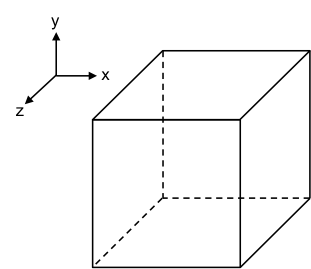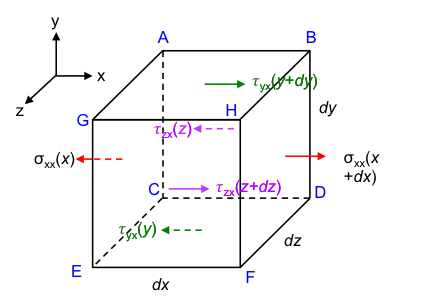The Navier-Stokes equation is used to describe the motion of a viscous fluid and was named after Claude-Louis Navier, a French scientist, and George Stokes, an Irish scientist. To derive the equation, let’s consider the flow of an incompressible fluid through an infinitesimal cubic control volume* depicted in the diagram below.

* the control volume here refers to the volume of an object in the fluid.
The x-component of the velocity of the fluid is a function of x, y, z and t, i.e. ux (x, y, z, t) where t is time. The total differential of ux is:
Dividing the equation by dt and letting dx/dt = ux, dy/dt = uy, dz/dt = uz, we have:

Let’s analyse the hydrostatic and hydrodynamic forces acting on each face of the infinitesimal control volume in the x-direction (see diagram above where point C is the origin). They are summarised as follows:
|
Face |
Force per unit area |
Force |
|
BDFH |
σxx(x + dx) | σxx(x + dx)dydz |
|
ACEG |
σxx(x) | σxx(x)dydz |
|
ABHG |
τyx(y + dy) | τyx(y + dy)dxdz |
|
CDFE |
τyx(y) | τyx(y)dxdz |
|
ABDC |
τzx(z) | τzx(z)dxdy |
|
GHFE |
τzx(z + dz) | τzx(z + dz)dxdy |
σxx = F/A , i.e. the force F acting on a unit area of the x-plane in the x-direction, thereby the double-x subscript. The notation σxx(x) refers to σxx evaluated at a distance of (x) while σxx(x + dx) is evaluated at a distance of (x + dx). A different notation τ is given to the forces that act parallel to the faces of the control volume, e.g. τyx(y + dy) is the force acting on a unit area of the y-plane in the x-direction that is evaluated at a distance of (y + dy).
With reference to the defined directions of the forces, FH the sum of hydrostatic and hydrodynamic forces acting on the infinitesimal control volume in the positive x-direction is:
In addition to hydrostatic and hydrodynamic forces, an inertia force Fg (gravitational force) also acts on the infinitesimal control volume in the x-direction:
where ρ is the density of the fluid and gx is the x-component of the acceleration due to gravity.
The total force FT acting on the infinitesimal control volume in the x-direction is therefore:
Next, by i) substituting FH and Fg and eq24 in eq25; ii) dividing the substituted equation by dxdydz and iii) letting dx, dy, dz → 0 for an infinitesimal control volume, we have:
Using the same logic and repeating the above steps, we have for the y-direction and the z-direction:
From the articles on constitutive relation, . We therefore substitute
,
and
in eq26, noting that
(see eq14) to give:
Using the same logic and repeating the above step for eq27 and eq28, we have:
Eq29, eq30 and eq31 are the Cartesian form of the Navier-Stokes equations, which when multiplied throughout by the unit vectors ,
and
respectively and summed, becomes the vector form:
where
is the convective derivative defined as
is the gradient defined as
is the vector Laplacian defined as
is the viscosity of the fluid
